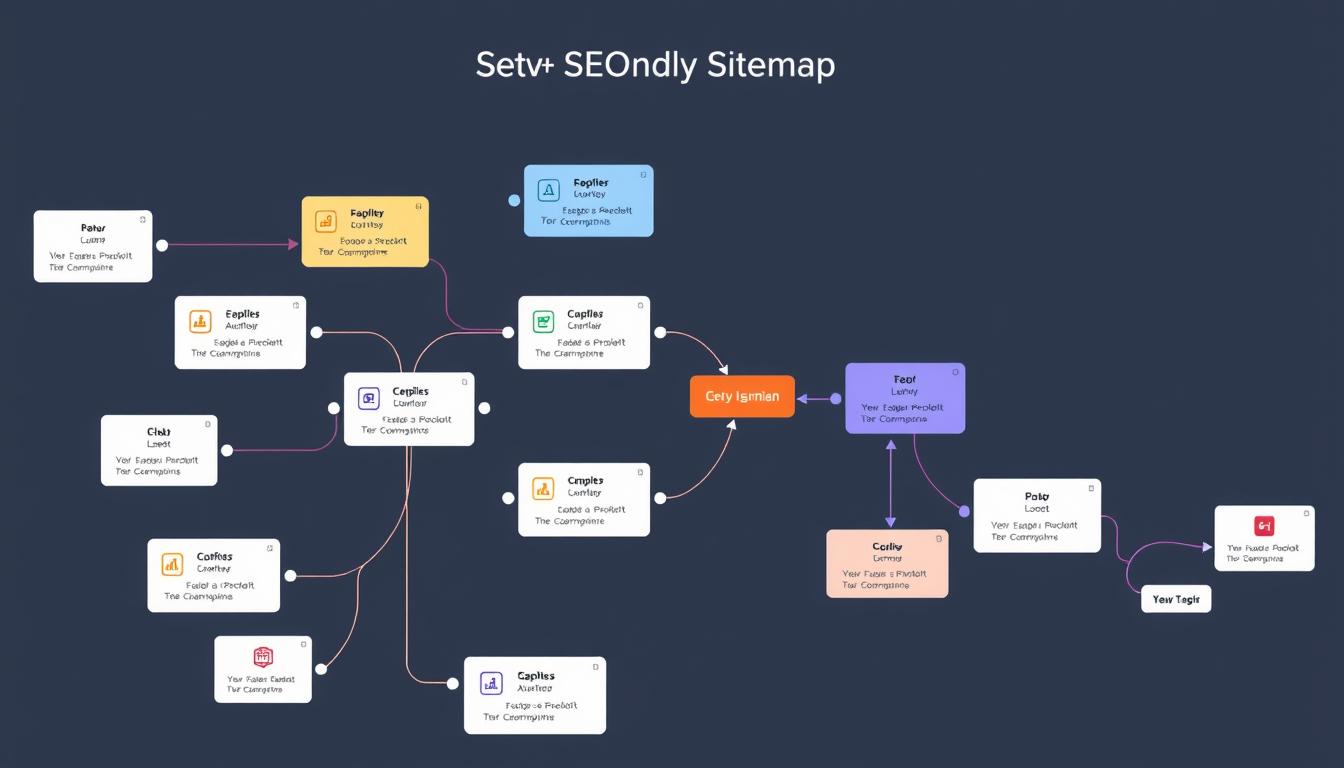Did you know that over 70% of websites are never indexed by search engines? This staggering statistic underscores the paramount importance of creating SEO-friendly sitemaps. A meticulously structured sitemap not only enhances website indexing but also significantly boosts your site’s visibility in search results. In today’s digital landscape, effective sitemap creation is indispensable for ensuring that search engines can crawl and understand your content. By prioritizing SEO optimization through sitemaps, you can guide search engines efficiently while improving user experience and driving traffic to your site.
When you implement an effective sitemap strategy, you’re taking a significant step toward better online visibility. This guide will delve into the essential components of crafting an SEO-friendly sitemap, outlining best practices and common pitfalls to avoid. As we explore the nuances of sitemap creation, you will discover how to streamline your website’s navigation and enhance your SEO ranking, all while making it easier for users to find what they need.
Learn more about whatan XML sitemap can do for your site
Key Takeaways
- Creating SEO-friendly sitemaps is crucial for improving website indexing.
- Structured sitemaps enhance user experience by making navigation easier.
- Effective sitemap creation can lead to higher search engine rankings.
- Improved visibility in search results increases potential website traffic.
- Regular updates and maintenance of sitemaps are essential to keep content relevant.
Understanding the Basics of SEO-Friendly Sitemaps
An SEO-friendly sitemap functions as a pivotal blueprint for any website, delineating all web pages and facilitating enhanced visibility for search engines. This structured format enables efficient crawling and indexing of content. The comprehension of these sitemaps’ importance can significantly influence a site’s performance in search rankings.
What is an SEO-Friendly Sitemap?
An SEO-friendly sitemap acts as a comprehensive guide for search engines, detailing the various pages on your site. It ensures that search engines can readily discover all pertinent web pages, thereby enhancing indexing. A well-structured sitemap simplifies website navigation, aiding both users and crawlers in finding information with ease.
Why Sitemaps Matter for SEO
Sitemaps are pivotal in SEO, directing search engines to the important pages of a website. With a clearly defined sitemap, the probability of being indexed correctly increases significantly, leading to higher visibility in search results. This, in turn, contributes to improving organic traffic and boosting overall search engine rankings.
Types of Sitemaps
Understanding the different types of sitemaps is crucial for optimizing website navigation and SEO efforts. Here are some common types:
- XML Sitemaps: Primarily used for search engines, providing a roadmap for bots to crawl the site efficiently.
- HTML Sitemaps: Designed for users, helping them navigate through the website more easily.
- Video Sitemaps: Focused on video content, ensuring that multimedia elements are indexed properly.
- Image Sitemaps: Similar to video sitemaps but dedicated to image assets, enhancing the indexing of visual content.
How to Create an SEO-Friendly Sitemap
The creation of an SEO-friendly sitemap is paramount for enhancing your website’s search engine visibility. Mastery of the requisite tools for sitemaps and the incorporation of critical elements will expedite the sitemap generation process. This discourse delves into the diverse sitemap generation methodologies, ranging from manual endeavors to automated processes.
Tools for Generating Sitemaps
Several tools for sitemaps are available to facilitate the generation of a sitemap. Prominent among these are:
- Google Sitemap Generator
- Screaming Frog
- XML-Sitemaps.com
These tools expedite the sitemap creation process, ensuring that your sitemap is properly structured and prepared for submission.
Key Elements to Include
In the construction of your sitemap, the inclusion of pivotal elements is imperative. Critical components encompass:
- URL structure – URLs must be clear and descriptive.
- Last modified dates – Accurate tracking of page updates is essential.
- Priority settings – Clearly indicate the significance of various pages.
Incorporating these elements with precision enhances the efficacy of your sitemap for search engines.
Manual vs. Automated Generation
The decision between manual generation and automated generation hinges on your website’s specific requirements. Manual generation affords developers granular control and customization, enabling meticulous tailoring of each element. Conversely, automated generation offers expediency and convenience, being particularly beneficial for extensive websites. An exploration of both methodologies can elucidate which approach aligns with your sitemap requirements most effectively. For further insights, refer to this resource.
Best Practices for Structuring Your Sitemap
Optimizing your website’s SEO through the structuring of sitemaps is paramount. A meticulously organized sitemap not only enhances navigation but also facilitates the discovery of critical content for both users and search engines. Adherence to certain best practices is imperative.
Organizing URLs Effectively
The cornerstone of an effective sitemap lies in the organization of URLs. A logical hierarchy that mirrors the site’s structure is essential. This facilitates crawling and indexing, allowing search engines to discern the interconnectivity of pages. To optimize organization, consider the following:
- Group related pages together.
- Use descriptive URLs that provide context.
- Avoid deep nesting of categories to ensure easy access.
Prioritizing Important Pages
Ensuring that critical pages receive adequate attention from search engines is vital. Identify the content that drives traffic and conversions. Prominent placement of these pages in the sitemap can lead to more frequent crawling. Regular evaluation of this aspect is crucial for a robust SEO strategy.
Keeping the Sitemap Updated
Regular updates to the sitemap are essential to reflect content or structural changes. Incorporate new pages and remove outdated ones to maintain accuracy. An updated sitemap prevents confusion for search engines and users, thereby supporting ongoing SEO performance.
Benefits of Using XML Sitemaps

XML sitemaps are indispensable for optimizing a website’s presence in search engines. They facilitate enhanced crawling and indexing, thereby significantly boosting visibility on search result pages. By mapping a website’s structure, XML sitemaps enable search engines to efficiently discover and prioritize critical content.
Enhanced Crawling and Indexing
Effective crawling and indexing are pivotal for achieving superior search rankings. XML sitemaps empower search engines to swiftly identify new content and updates. This expedites the process of keeping your site relevant and current in search engine algorithms. Furthermore, the inclusion of structured data within XML sitemaps allows search engines to discern the hierarchy and significance of each webpage.
Improving User Experience
An organized sitemap enhances user experience by directing visitors to the most pertinent content. It simplifies navigation, allowing users to effortlessly find their desired information. This ease of navigation encourages prolonged engagement, potentially leading to increased conversion rates and a more favorable brand perception.
Supporting Video and Image SEO
XML sitemaps play a crucial role in optimizing video and image SEO. By incorporating specific tags for these media types, search engines can more effectively index and promote them. This ensures that multimedia content receives the necessary attention, enhancing visibility across various platforms. Such increased visibility attracts more visitors seeking rich media content. For comprehensive information on website policies, refer to the terms of use.
Integrating Sitemaps with Google Search Console
The integration of your sitemap with Google Search Console is paramount for enhancing your website’s discoverability. This indispensable tool empowers site proprietors to oversee and monitor sitemaps with precision. The initiation of this process involves the submission of sitemaps, facilitating search engines’ ability to locate and index your website’s content efficiently.
Submitting Your Sitemap
To augment your site’s SEO efficacy, the act of submitting sitemaps through Google Search Console is indispensable. For those seeking assistance, refer to this resource on constructing sitemaps. Post-creation of an XML sitemap, proceed to the “Sitemaps” section within the console and input your sitemap URL. This action not only notifies Google of your sitemap’s existence but also facilitates enhanced indexing.
Monitoring Sitemap Performance
Post-submission, the monitoring of sitemap performance becomes imperative. The examination of performance metrics within Google Search Console offers site proprietors invaluable insights into Google’s crawling efficacy. This evaluation encompasses the assessment of indexed pages and the identification of any crawling-related errors.
Troubleshooting Common Issues
Despite potential challenges, the mastery of troubleshooting can markedly enhance your sitemap’s functionality. Frequent issues encompass submission errors or sluggish crawl rates. Resolution of these problems necessitates regular console monitoring for alerts and the implementation of necessary adjustments to your sitemap’s architecture. Such actions guarantee a more seamless interaction between search engines and users.
Mobile-Friendly Sitemaps: An Essential Guide

The ascendance of mobile internet usage underscores the critical role of mobile optimization in sitemap creation. A meticulously crafted sitemap, tailored for mobile users, not only elevates user experience but also significantly enhances the likelihood of proper indexing by search engines. The adoption of mobile-friendly sitemaps ensures optimal performance across a spectrum of devices. Irrespective of the device—smartphone or tablet—users should experience a seamless navigation.
Importance of Mobile Optimization
The emphasis on mobile optimization fulfills several objectives. It facilitates effortless navigation and content discovery, thereby reducing user frustration. Google’s preference for mobile-optimized sites mirrors the escalating trend of mobile browsing. Consequently, the implementation of mobile-friendly sitemaps guarantees the accessibility of critical pages. By catering to mobile users, enterprises can substantially elevate their site’s performance.
Adjusting for Mobile and Desktop Versions
Developing distinct mobile-friendly sitemaps necessitates an understanding of the divergent behaviors of mobile and desktop users. This entails the provision of customized URL structures tailored to specific device categories. Adherence to the following best practices is advisable:
- Analyze user interactions on mobile versus desktop to pinpoint optimization priorities.
- Utilize separate sitemaps for mobile and desktop versions to address the unique requirements of each demographic.
- Engage in continuous monitoring and updates of both sitemaps, leveraging tools or resources outlined here.
By implementing these measures, businesses can forge effective pathways for both mobile and desktop users, ensuring their sites remain accessible across all platforms. Prioritizing mobile optimization in sitemap design is pivotal for enhancing overall visibility and accessibility.
Common Mistakes to Avoid in Sitemap Creation
The creation of an efficacious sitemap is paramount for enhancing your website’s discoverability. Webmasters often succumb to common errors that can severely impede search engine optimization. Identifying these pitfalls is crucial to guarantee that your sitemap serves its intended purpose and contributes positively to your SEO endeavors.
Overloading with URLs
One prevalent error is the inclusion of an excessive number of URLs within a sitemap. Although the intention may be to catalog every webpage, this approach can perplex search engine crawlers. Such an overloaded sitemap may result in incomplete indexing, thereby hindering the discovery of critical pages. A streamlined and organized sitemap, on the other hand, optimizes its utility and facilitates search engines’ prioritization of your content.
Ignoring Robots.txt
Another critical oversight is the neglect of the directives outlined in the robots.txt file. This file delineates which pages should be crawled and which should be excluded. If certain sections of your site are inadvertently blocked by this file, valuable content may go unnoticed. It is imperative to ensure that your sitemap and robots.txt file are in sync. Verifying that your sitemap references pages not restricted by the robots.txt file is essential for optimal indexing.
Failing to Update Regularly
Consistent sitemap updating is indispensable for a robust SEO strategy. Websites are constantly evolving, with new pages being introduced and outdated content being deprecated. Failure to update your sitemap can result in dead links and outdated information, compromising both usability and performance. A sitemap that accurately reflects your current site structure will improve user experience and assist search engines in locating and indexing your most recent content.
How Sitemaps Enhance Local SEO
Sitemaps are pivotal in augmenting local SEO efficacy. They facilitate the integration of local content, enabling businesses to forge deeper connections with their target demographics. This strategy not only amplifies visibility but also boosts engagement with potential customers within specific geographic locales.
Importance of Local Content
By embedding local content within sitemaps, businesses can prioritize information germane to their communities. For example, highlighting local events, store hours, or promotions can significantly attract nearby clientele. Such a strategy can lead to an uptick in local search traffic. Content that resonates with the local audience cultivates trust and stimulates foot traffic, potentially leading to increased conversion rates.
Building Geographic Relevance
Geographic relevance is achieved through sitemaps by effectively listing local pages and pertinent resources. By ensuring the inclusion of diverse local pages, businesses can bolster their online presence within the community. This geographic relevance aids search engine algorithms in linking the website to specific locations, thereby enhancing its ranking in local search results. This tactic drives more traffic from local searches, thereby optimizing overall marketing endeavors.
Future Trends in Sitemap Optimization
The trajectory of sitemap optimization is undergoing a transformative evolution, with the ascendance of voice search as a pivotal trend. The increasing reliance on voice-activated technology for information acquisition necessitates a reevaluation of sitemap structures. To accommodate this shift, optimizing for voice search requires a focus on natural language queries and ensuring content accessibility on devices such as smart speakers. It is crucial for site proprietors to adapt their sitemap strategies to capitalize on this burgeoning medium’s potential.
Voice Search and Sitemaps
Voice search queries exhibit distinct characteristics compared to traditional typed searches, underscoring the imperative for sitemaps to emphasize concise and pertinent content. By integrating keywords reflective of common voice-activated inquiries, enterprises can enhance their visibility in these search outcomes. Furthermore, optimizing sitemaps to facilitate access to local content supports voice search, mirroring user preferences for verbal information requests. This alignment not only enriches user experiences but also augments search engine performance.
AI Impact on Sitemap Creation
The advent of AI technologies is significantly influencing the realm of sitemap creation. AI-driven sitemap generation automates the process, ensuring sitemaps remain current with the latest URLs. This innovation alleviates the drudgery of manual updates, elevating sitemap quality and, consequently, SEO efficacy. Engaging with AI can offer substantial support for optimizing sitemaps effectively. For those contemplating the adoption of more sophisticated practices, consider contacting this link for specialized guidance.
